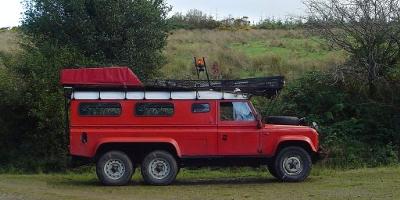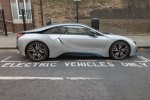Separate Axle For My Hybrid Electric Car Conversion?
by John
(Cambridge, UK)

Stretched Land-Rover Electric Car Conversion
I'm planning to stretch and convert my long-wheelbase Land-Rover Defender to a six-wheeler (i.e. add another axle behind the present rear one, with a custom chassis and an extra section of bodywork), and have been thinking about various ways to get the drive to the third axle. (The Defender is permanent four-wheel drive, with a central diff to split the power between axles, and an ordinary diff in each axle.) I was also already thinking that I'd like to convert it to a hybrid later.
I've now realized that hybridization could be the answer to getting power to the extra axle: leave the power train from the diesel engine to the existing axles undisturbed, and add a motor to drive the third axle. Then for long journeys and for most off-roading, I can use the diesel, for short slower journeys I can use just the electric, (my daily round trip is 20 miles, and I'm happy to recharge from the grid nightly), and if I get stuck with the centre axle off the ground over a ditch while off-roading, I can add in the electrics to push the rear of the vehicle.
Of course, there'll be all sorts of extra bits. The ones I can think of right away are needing an electric vacuum pump for the brake servo, and possibly needing air suspension on the new rear axle (or both rear axles) to shift more of the weight onto whichever of the rear axles is providing drive.
I'm posting this mostly for "any thoughts?" but I've also got a couple of specific questions: (1) should I mount the motor to the chassis and use a prop shaft, or mount the motor directly to the axle where the prop shaft would normally go (I reckon probably to the chassis), and (2) I could top up the batteries from a dynamo driven from the engine fanbelt (perhaps even the normal vehicle alternator) but how about recharging them from forward motion when driving on diesel? Would that be much less efficient than making the connection electrically?
Hi, John!
First a disclaimer, because you're asking some pretty sophisticated questions and this is the 101 class here. You might be better served to ask your questions over at the DIY Electric Car Forums or the EVDL.
But since you asked ME, I'll tell you what I think. Question one is really a decision about simplifying by eliminating an apparently unneeded part vs. mounting the motor in a spot with more room and place to bolt it on sturdily with less vibration. Either way, it sounds like you're mounting your motor to the chassis. The question is where, right?
I guess my vote is to mount it to the chassis, yes, where there's room to accommodate it and cool it adequately, while at the same time protecting it as much as possible from water and vibration. You'll also need to wire it to the controller, so where's that going to go?
Mechanical losses might be of secondary importance to stuff like waterproofing, space, and vibration.
Next question, I'd say yes, what you're thinking of is less efficient than making the connection electrically. I think so. Instead of generating electricity directly from the gas engine, you're converting gas engine energy to kinetic energy in the wheels and then converting that energy back to electric. Losses at every step.
I don't think the vacuum pump for the brakes, etc, should be any kind of problem. All that stuff is available from various electric car conversion parts companies.
I'm not familiar with EV parts companies in the UK, so my recommendations would be useless to you unless you want to import from the US!
Best of luck with your project, John.
Regards,
Lynne

